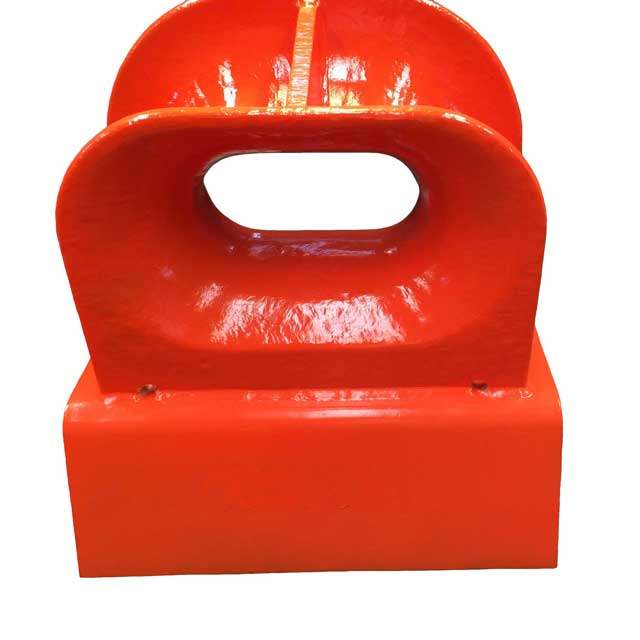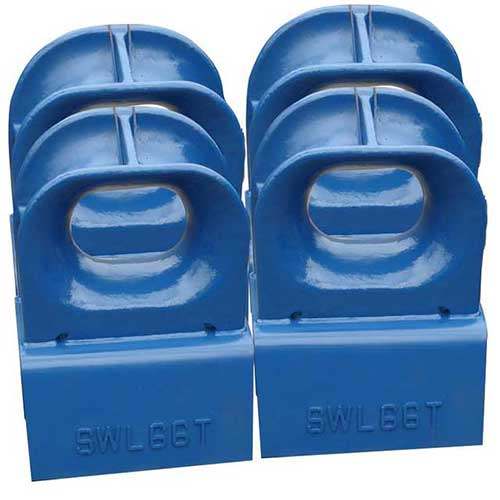Mooring chocks are used to secure mooring lines, which are used to anchor or dock a vessel to a berth, jetty, or other mooring points, and distribute the load from the mooring lines, preventing excessive stress or damage to the ship’s structure. They are used for docking, anchoring, and fastening vessels during loading and unloading activities.

Mooring Chock Material Selection
Marine mooring chock materials must be carefully selected to ensure their lifespan, strength, and resistance to corrosion and wear in the harsh marine environment.
When selecting materials for mooring chocks, several factors are taken into account.
Strength and load bearing capacity.
Marine mooring chocks are subjected to heavy weights and stresses from mooring lines, which vary depending on vessel size and type, as well as environmental conditions. As a result, mooring chocks are typically manufactured of high tensile strength and load-bearing materials, such as steel, to ensure that they can withstand the imposed loads without deformation or failure.
Corrosion Protection
Because of the presence of saltwater, marine environments are very corrosive, causing metals to corrode quickly. To ensure long-term performance and durability, materials with superior corrosion resistance, such as stainless steel, bronze, or high-quality composites, are often utilized for mooring chocks.
Wear Resistance
Mooring chocks can wear out over time owing to friction with mooring lines, resulting in surface damage or erosion. Hardened steel or long-lasting composites, for example, are routinely used to decrease wear and increase the life of mooring chocks.
Weight and Density
The weight and density of the materials used for mooring chocks can have an impact on the total weight and stability of the vessel. Low density materials, such as aluminum or some composites, can be used to make mooring chocks lighter without compromising strength or longevity.
Cost
The cost of mooring chocks also influences material choices. While stainless steel and bronze are extremely strong and resistant to corrosion, they may be more expensive than other materials. As a result, a balance of performance, durability, and cost must be considered while selecting materials.

Common materials used for mooring chocks
Steel
Steel is a preferred material for mooring chocks due to its high strength, load-bearing capacity, and longevity. It can be used in mild steel, high-tensile steel, or stainless steel, depending on the application and environmental conditions.
Bronze
Bronze is a corrosion-resistant material that is commonly used in maritime applications like mooring chocks. It offers high strength, wear resistance, and endurance, making it perfect for mooring chocks that must operate well and resist corrosion.
Composites
Fiberglass reinforced plastic (FRP) and carbon fiber reinforced plastic (CFRP) are lightweight, corrosion-resistant, and have a high strength-to-weight ratio. They are increasingly being employed in marine applications such as mooring chocks due to their excellent performance.
Aluminum
Aluminum is a lightweight material with moderate strength and resistance to corrosion. When weight reduction is desired, it is commonly used for mooring chocks on small boats or lightweight vessels.
Structural Components And Features Of Mooring Chock
Marine mooring chocks are frequently made up of multiple structural components and have certain design elements to ensure optimum performance.
Chock Body
The primary body of the mooring chock is often a strong metal or composite construction that serves as the chock’s main framework. It could be shaped like a U or V, with smooth, rounded sides to protect the mooring lines. The chock body is designed to bear mooring line loads and distribute them equally to the vessel’s structure.
Mounting Base
A mounting base or flange is often used to secure the mooring chock to the vessel’s deck or hull. The mounting base is intended to securely attach the mooring chock to the framework of the vessel, providing stability and strength during mooring operations.
Fairlead
A fairlead is a guiding element in the chock body that helps to direct and guide mooring lines as they pass through the chock. It prevents mooring lines from rubbing against the chock body, thereby reducing line wear and tear and ensuring smooth movement during mooring operations.
Rollers or Sheaves
Rollers or sheaves are integrated into the body of some mooring chocks. These are designed to reduce friction on the mooring lines as they pass through the chock, resulting in less line wear and tear and smoother movement.
Bolts or Fasteners
To secure maritime mooring chocks to the vessel's frame, bolts or fasteners are frequently employed. To maintain the mooring chock securely connected to the vessel during mooring operations, these bolts or fasteners are sturdy and corrosion-resistant.
Drainage Holes
Drainage holes or channels in mooring chocks allow water to drain away from the chock, avoiding water accumulation and lowering corrosion risk.
Load Ratings and Markings
Mooring chocks frequently have load ratings or signage indicating maximum load-bearing capability. This data ensures that the chocks are used within their design parameters and acts as a reference for safe mooring operations.
Proper Orientation and Placement
Marine mooring chocks are frequently built with certain orientation and position requirements to ensure optimal function. They are commonly installed in critical regions of the vessel to ensure appropriate force distribution and safe and successful mooring operations.

Innovations Of Mooring Chocks
Mooring chock materials, technologies, and designs have been continuously updated to improve performance, longevity, and safety.
Composite Materials
Traditional marine mooring chocks are generally made of metals such as steel or cast iron. Composite materials, on the other hand, are increasingly being used in marine mooring chocks due to features such as high strength-to-weight ratio, corrosion resistance, and reduced maintenance requirements. Composite materials, such as fiberglass-reinforced polymers (FRP), are used to make chock bodies, rollers, and fairleads, which provide greater durability and service life.
Non-metallic Coatings
Non-metallic coatings for marine mooring chocks have been developed as a result of developments in coating technology, providing improved corrosion resistance, less friction, and longer longevity. Specialized polymer coatings, epoxy coatings, or other corrosion-resistant coatings may be used to help mooring chocks last longer and require less maintenance.
3D Printing
Additive manufacturing, also known as 3D printing, is quickly becoming popular in the production of marine mooring chocks. Because 3D printing allows for complex geometry and customization, mooring chocks with optimized designs and improved performance are possible. 3D printing has the potential to enable more sustainable production processes by reducing material waste and energy use.
Integrated Load Monitoring
Some marine mooring chocks now have integrated load monitoring devices, such as load cells or strain gauges, that allow real-time monitoring of the loads applied to the chock. This improves safety by providing feedback on the actual loads faced by the chock during mooring operations, allowing for preventative maintenance and avoiding overloading.
Design Optimization
Advances in computer-aided design (CAD) and finite element analysis (FEA) have enabled optimized designs for maritime mooring chocks. Computational simulations can be used to anticipate and analyze mooring chock performance under various loads and environmental conditions, resulting in superior designs with more strength, better load distribution, and lower stress concentrations.
Environmentally-friendly Designs
Design advances in marine mooring chocks also address environmental sustainability. Some mooring chocks, for example, are designed with rounded curves and smooth surfaces to reduce the possibility of marine animal entanglement and, as a result, the impact on marine ecosystems.
